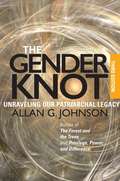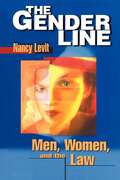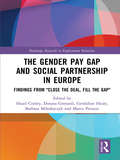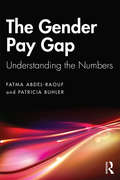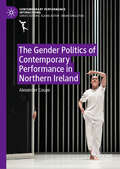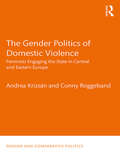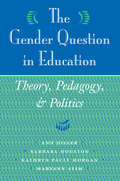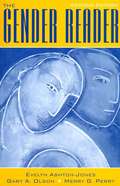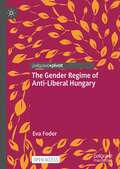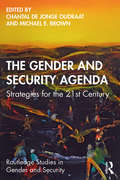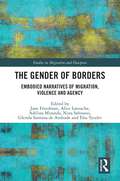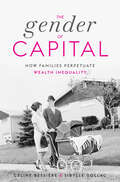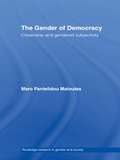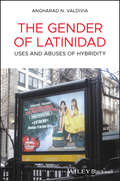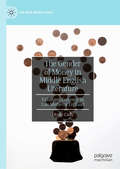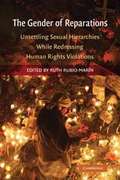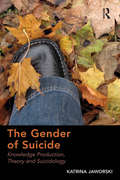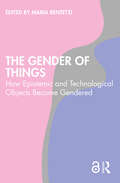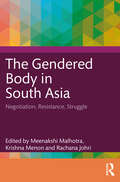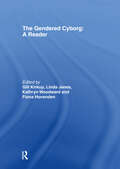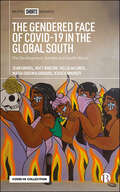- Table View
- List View
The Gender Knot: Unraveling Our Patriarchal Legacy; Third Edition
by Allan G. JohnsonNew Third Edition! The Gender Knot, Allan Johnson's response to the pain and confusion that men and women experience by living with gender inequality, explains what patriarchy is and isn't, how it works, and what gets in the way of understanding and doing something about it. Johnson's simple yet powerful approach avoids the paralyzing trap of guilt, blame, anger, and defensive denial that often results from conversations about gender. This edition features: • Updated references, data, resources, and examples, especially in relation to issues of sexual orientation and gender identity (e.g., gay marriage, transgender/cisgender) • A glossary of terms • A new chapter, "What Changes and What Does Not: Manhood and Violence," that provides an extended analysis of the causes of men's violence as a patriarchal phenomenon
The Gender Line: Men, Women, and the Law (Critical America #78)
by Nancy LevitDespite tremendous advances in civil rights, we live in a world where the sexes remain sharply segregated from birth to death: in names, clothing, social groupings, and possessions; in occupations, civic association, and domestic roles. Gender separatism, so pervasive as to be almost invisible, permeates the fabric of our daily social routines. Preferring a notion of gender that is fluid and contextual, and denying that separatism is inevitable, Nancy Levit dismantles the myths of gender essentialism Drawing on a wealth of interdisciplinary data regarding the biological and cultural origins of sex differences, Levit provides a fresh perspective on gendered behaviors and argues the need for careful cultivation of new relations between the sexes. With its focus particularly on men, The Gender Line offers an insightful overview of the construction of gender and the damaging effects of its stereotypes. Levit analyzes the ways in which law legitimizes the social segregation of the sexes through legal decisions regarding custody, employment, education, sexual harassment, and criminal law. In so doing, she illustrates the ways in which men's and women's oppressions are intertwined and how law molds the very definition of masculinity. Applying feminist methodology to the doctrine of feminism itself, Levit artfully demonstrates that gender separatism infects even our contemporary views of feminism. Levit asks questions that have been too long been unspoken--those that lie at the core of the feminist project, yet threaten its very foundations. Revealing masculinity as both a privileged and a victimized condition, she calls for a step forward, past the bounds of contemporary feminism and its conflicts, toward a more egalitarian and inclusive feminism. This brand of feminism would reshape traditional masculinity, invite men into feminist dialogue, and claim men as political allies.
The Gender Pay Gap and Social Partnership in Europe: Findings from "Close the Deal, Fill the Gap" (Routledge Research In Employment Relations Ser.)
by Geraldine Healy Hazel Conley Donata Gottardi Barbara Mikołajczyk Marco PeruzziThe gender pay gap (GPG) exists in every European country, but it varies considerably, even in EU member states covered by the same legal principles on pay equality. Part of the variation can be explained by different patterns of social partnership. With current policy pressure to de-centralise collective bargaining and increase the percentage of pay linked to productivity, what role can social partnership play in tackling the GPG? Reporting on the findings of the European Commission funded research project "Close the Deal, Fill the Gap", this book uses an interdisciplinary analysis involving legal, economic, and sociological expertise, to explore the role of social partnership in GPG in Italy, Poland and the UK. Selected on the basis of their contrasting profiles in terms of legal regulation, industrial relations, systems of collective bargaining, coverage of collective agreements, and differing rates of the GPG, the in-depth study provides important insights into the main issues underlying the problem of reducing the gender pay gap which have led to guidelines in the negotiation of arrangements on GPG-related issues. Based on a unique comparative, interdisciplinary and action-oriented esearch project, it will be of great interest to all researchers and advanced students with an interest in women’s representation in the workforce and the gender pay gap, as well as practitioners and policy makers in organisations such as trade unions and employers’ associations.
The Gender Pay Gap: Understanding the Numbers
by Patricia M. Buhler Fatma Abdel-RaoufClosing the gender pay gap begins with awareness and understanding of the state of the gap. This hybrid book that serves as a resource for both the academic and corporate communities, builds the reader’s awareness of the gender pay gap, its magnitude and ramifications, and provides action plans to address the challenge. Much of the existing literature on the gender pay gap provides an excellent foundation in stating facts and inferences; yet, the reader is often left wondering "now what?" This book tells the story of the state of the gap by the numbers and then offers specific actions that can be taken to achieve equity. The authors combine backgrounds in statistics and management/HR to provide a unique perspective in painting a broader overview of the issue, examining the history of the gender pay gap, its global impact, and how nations are addressing the issue. The book shines a light on the wide-ranging effects of the gap, including women’s poverty rates, student loans, economic growth, childhood poverty, and corporate profits, and offers insights to help close it with best practices of select organizations. Upper-level undergraduate, postgraduate, and executive education students will appreciate the clarity and conciseness of this guide to understanding and solving an important human resources issue. The inclusion of a brief instructor’s manual and PowerPoint slides for each chapter differentiates this book and adds to the ease of adoption in both the academic and corporate setting.
The Gender Politics of Contemporary Performance in Northern Ireland (Contemporary Performance InterActions)
by Alexander CoupeThis book examines theatre and performance produced since the 1998 Belfast/Good Friday Agreement in the context of growing discontent with the failure of the peace in Northern Ireland to deliver genuinely transformative forms of social justice. The economic expansion that attended the peace accord propelled the growth of the region’s theatre and performance sector and assisted in increasing the representation of women and LGBTQ+ people across the arts. Despite this, much of the performance work produced since 1998 has illuminated the darker social consequences of Northern Ireland’s embrace of a specifically neoliberal vision of a ‘post-conflict’ society. Existing scholarship has already highlighted the role of theatre and performance in drawing attention to the misogyny and homophobia that has underwritten political antagonism in the North since partition. Instead, this book offers a sustained examination of contemporary performance makers that have engaged specifically with the reconstruction of gender norms amidst the region’s political and economic transformation. The story it tells is of an emerging current in theatre, performance art, and dance consisting of work concerned not only with uncovering the morbid symptoms of the neoliberal peace but also embodying those messy and everyday conditions of co-dependency, vulnerability and solidarity that both patriarchal nationalisms and androcentric individualism seek to deny.
The Gender Politics of Domestic Violence: Feminists Engaging the State in Central and Eastern Europe (Gender and Comparative Politics)
by Conny Roggeband Andrea KrizsánWhat are the factors that shape domestic violence policy change and how are variable gendered meanings produced in these policies? How and when can feminists influence policy making? What conditions and policy mechanisms lead to progressive change and which ones block it or lead to reversal? The Gender Politics of Domestic Violence analyzes the emergence of gender equality sensitive domestic violence policy reforms in Central and Eastern Europe (CEE). Tracing policy developments in Eastern Europe from the beginning of 2000s, when domestic violence first emerged on policy agendas, until 2015, Andrea Krizsán and Conny Roggeband look into the contestation that takes place between women’s movements, states and actors opposing gender equality to explain the differences in gender equality sensitive policy outputs across the region. They point to regionally specific patterns of feminist engagement with the state in which coalition-building between women’s organizations and establishing alliances with different state actors were critical for achieving gendered policy progress. In addition, they demonstrate how discursive contexts shaped by democratization frames and opposition to gender equality, led to differences in the politicization of gender equality, making gender friendly reforms more feasible in some countries than others.
The Gender Question in Education: Theory, Pedagogy, and Politics
by Ann Diller<p>In this innovative book, four prominent philosophers of education introduce readers to the central debates about the role of gender in educational practice, policymaking, and theory. More a record of a continuing conversation than a statement of a fixed point of view, The Gender Question in Education enables students and practicing teachers to think through to their own conclusions and to add their own voices to the conversation. <p>Throughout, the authors emphasize the value of a gender-sensitive perspective on educational issues and the relevance of an ethics of care for educational practice. Among the topics discussed are feminist pedagogy, gender freedom in public education, androgyny, sex education, multiculturalism, the inclusive curriculum, and the educational significance of an ethics of care. <p>The multiauthor, dialogic structure of this book provides unusual breadth and cohesiveness as well as a forum for the exchange of ideas, making it both an ideal introduction to gender analysis in education and a model for more advanced students of gender issues.
The Gender Reader
by Gary A. Olson Merry G. Perry Evelyn Ashton-JonesThe readings represent a balanced view of several gender-related topics and have been chosen to provide a background for rich discussion and thoughtful essays. The issues raised throughout the book are designed to provide readers with opportunities for personal and reflective writing as well as expository and argumentative writing.
The Gender Regime of Anti-Liberal Hungary
by Eva FodorThis Open Access book explains a new type of political order that emerged in Hungary in 2010: a form of authoritarian capitalism with an anti-liberal political and social agenda. Eva Fodor analyzes an important part of this agenda that directly targets gender relations through a set of policies, political practice and discourse—what she calls “carefare.” The book reveals how this is the anti-liberal response to the crisis-of-care problem and establishes how a state carefare regime disciplines women into doing an increasing amount of paid and unpaid work without fair remuneration. Fodor analyzes elements of this regime in depth and contrasts it to other social policy ideal-types, demonstrating how carefare is not only a set of policies targeting women, but an integral element of anti-liberal rule that can be seen emerging globally.
The Gender Trap: Parents and the Pitfalls of Raising Boys and Girls
by Emily W. KaneA detailed account of how gender is learned and unlearned in the homeFrom the selection of toys, clothes, and activities to styles of play and emotional expression, the family is ground zero for where children learn about gender. Despite recent awareness that girls are not too fragile to play sports and that boys can benefit from learning to cook, we still find ourselves surrounded by limited gender expectations and persistent gender inequalities. Through the lively and engaging stories of parents from a wide range of backgrounds, The Gender Trap provides a detailed account of how today’s parents understand, enforce, and resist the gendering of their children. Emily Kane shows how most parents make efforts to loosen gendered constraints for their children, while also engaging in a variety of behaviors that reproduce traditionally gendered childhoods, ultimately arguing that conventional gender expectations are deeply entrenched and that there is great tension in attempting to undo them while letting 'boys be boys' and 'girls be girls.'
The Gender and Security Agenda: Strategies for the 21st Century (Routledge Studies in Gender and Security)
by Michael E. Brown Chantal De Jonge OudraatThis book examines the gender dimensions of a wide array of national and international security challenges. The volume examines gender dynamics in ten issue areas in both the traditional and human security sub-fields: armed conflict, post-conflict, terrorism, military organizations, movement of people, development, environment, humanitarian emergencies, human rights, governance. The contributions show how gender affects security and how security problems affect gender issues. Each chapter also examines a common set of key factors across the issue areas: obstacles to progress, drivers of progress and long-term strategies for progress in the 21st century. The volume develops key scholarship on the gender dimensions of security challenges and thereby provides a foundation for improved strategies and policy directions going forward. The lesson to be drawn from this study is clear: if scholars, policymakers and citizens care about these issues, then they need to think about both security and gender. This will be of much interest to students of gender studies, security studies, human security and International Relations in general.
The Gender of Borders: Embodied Narratives of Migration, Violence and Agency (Studies in Migration and Diaspora)
by Jane Freedman Nina Sahraoui Alice Latouche Adelina Miranda Glenda Santana de Andrade Elsa TyszlerThis book brings an intersectional perspective to border studies, drawing on case studies from across the world to consider the ways in which notably gender and race dynamics change the ways in which people cross international borders, and how diffuse and virtual borders impact on migrants' experiences.By bringing together 11 ethnographies, the book demonstrates the necessity for in-depth empirical research to understand the class, gender and race inequalities that shape contemporary borders. In doing so the volume sheds light on how migration control produces gendered violence at physical borders but also through the politics of vulnerability across borders and social boundaries. It places embodied narratives at the heart of the analysis which sheds light on the agency and the many patterns of resistance of migrants themselves. As such, it will appeal to scholars of migration and diaspora studies with interests in gender.
The Gender of Capital: How Families Perpetuate Wealth Inequality
by Sibylle Gollac Céline BessièreTwo leading social scientists examine the gender wealth gap in countries with officially egalitarian property law, showing how legal professionals—wittingly and unwittingly—help rich families and men maintain their privilege.In many countries, property law grants equal rights to men and women. Why, then, do women still accumulate less wealth than men? Combining quantitative, ethnographic, and archival research, The Gender of Capital explains how and why, in every class of society, women are economically disadvantaged with respect to their husbands, fathers, and brothers. The reasons lie with the unfair economic arrangements that play out in divorce proceedings, estate planning, and other crucial situations where law and family life intersect.Céline Bessière and Sibylle Gollac argue that, whatever the law intends, too many outcomes are imprinted with unthought sexism. In private decisions, old habits die hard: families continue to allocate resources disproportionately to benefit boys and men. Meanwhile, the legal profession remains in thrall to assumptions that reinforce gender inequality. Bessière and Gollac marshal a range of economic data documenting these biases. They also examine scores of family histories and interview family members, lawyers, and notaries to identify the accounting tricks that tip the scales in favor of men.Women across the class spectrum—from poor single mothers to MacKenzie Scott, ex-wife of Amazon billionaire Jeff Bezos—can face systematic economic disadvantages in divorce cases. The same is true in matters of inheritance and succession in family-owned businesses. Moreover, these disadvantages perpetuate broader social disparities beyond gender inequality. As Bessière and Gollac make clear, the appropriation of capital by men has helped to secure the rigid hierarchies of contemporary class society itself.
The Gender of Democracy: Citizenship and Gendered Subjectivity (Routledge Research in Gender and Society #Vol. 12)
by Maro Pantelidou MaloutasAs developments in the European Union and elsewhere make the re-examination of citizenship a pressing issue, this book reflects on the persisting "masculine" character of contemporary democracy and the measures taken in the EU to combat it. Combining a theoretical approach with a specific critique of EU gender policy, The Gender of Democracy argues that substantial democracy as a social project cannot co-exist with the existing system of gender relations ,which are inherently dichotomous and thus demarcate social categories of superior and inferior status. Drawing on utopian thought, Maro Pantelidou Maloutas proposes a re-examination of the notion of the gendered subject and a revision of the dominant perceptions of the relations between sex, sexuality and gender. The book contains a critique of specific EU gender policies and shows how in seeking to do away with gender inequality, simply formulating policies that are pro-women is not enough. In order to approach democracy’s emancipatory component, far-reaching policies which deconstruct rather than modernize gender relations are needed.
The Gender of History: Men, Women, and Historical Practice
by Bonnie G. SmithIn this pathbreaking study of the gendering of the practices of history, Bonnie Smith resurrects the amateur history written by women in the nineteenth century--a type of history condemned as trivial by "scientific" male historians. She demonstrates the degree to which the profession defined itself in opposition to amateurism, femininity, and alternative ways of writing history. The male historians of the archive and the seminar claimed to be searching for "genderless universal truth," which in reality prioritized men's history over women's, white history over nonwhite, and the political history of Western governments over any other. Meanwhile, women amateurs wrote vivid histories of queens and accomplished women, of manners and mores, and of everyday life. Following the profession up to 1940, The Gender of History traces the emergence of a renewed interest in social and cultural history which had been demeaned in the nineteenth century, when professional historians viewed themselves as supermen who could see through the surface of events to invisible meanings and motives. But Smith doesn't let late twentieth-century historians off the hook. She demonstrates how, even today, the practice of history is propelled by fantasies of power in which researchers imagine themselves as heroic rescuers of the inarticulate lower classes. The professionals' legacy is still with us, as Smith's extraordinary work proves.
The Gender of Latinidad: Uses and Abuses of Hybridity
by Angharad N. ValdiviaPresents innovative scholarship on Latina/o visibility in contemporary mainstream media Latina/os have seen increased visibility in the media in the past several years, especially in feature-length films, network television programs, and various digital platforms. The Gender of Latinidad: Uses and Abuses of Hybridity explores Latina/o visibility—analyzing presence, production, and interpretation throughout various media. An important contribution to the emerging field of Latina/o Media Studies, this unique volume brings together political economy and cultural studies to consider the limitations of cultural politics and explore current issues relevant to Latina/o cultural inclusion. Author Angharad N. Valdivia addresses the concept of hybridity and applies it to contemporary Latinidad, in which hybrid Latina/os lead hybrid lives and consume hybrid media. The text explores strategies for gendered visibility in a range of popular culture media, using the concept of hybridity to connect Latina/o Studies to Feminist Media Studies, Gender Studies, and Ethnic Studies. Throughout the text, the author discusses the inclusion Latina/o scholars and audiences seek and considers if such inclusion is even achievable. Offering intersectional exploration of Latinidad in mainstream media, this volume: Explores the trope of the spitfire in the context of popular media Brings Disney Studies into Latina/o Studies Discusses the dynamic inclusion of Latinidad in awards ceremonies Assesses the implicit utopias of Latina/o representation Presents the only major academic treatment of Charo Presenting an original perspective on Latina/os in media, The Gender of Latinidad: Uses and Abuses of Hybridity is an ideal text for students and scholars in areas including Gender Studies, Ethnic Studies, and general Media and Feminist Media Studies.
The Gender of Modernity
by Rita FelskiIn an innovative and invigorating exploration of the complex relations between women and the modern, Rita Felski challenges conventional male-centered theories of modernity. She also calls into question those feminist perspectives that have either demonized the modern as inherently patriarchal, or else assumed a simple opposition between men’s and women’s experiences of the modern world. Combining cultural history with cultural theory, and focusing on the fin de siècle, Felski examines the gendered meanings of such notions as nostalgia, consumption, feminine writing, the popular sublime, evolution, revolution, and perversion. Her approach is comparative and interdisciplinary, covering a wide variety of texts from the English, French, and German traditions: sociological theory, realist and naturalist novels, decadent literature, political essays and speeches, sexological discourse, and sentimental popular fiction. Male and female writers from Simmel, Zola, Sacher-Masoch, and Rachilde to Marie Corelli, Wilde, and Olive Schreiner come under Felski’s scrutiny as she exposes the varied and often contradictory connections between femininity and modernity. Seen through the lens of Felski’s discerning eye, the last fin de siècle provides illuminating parallels with our own. And Felski’s keen analysis of the matrix of modernism offers needed insight into the sense of cultural crisis brought on by postmodernism.
The Gender of Money in Middle English Literature: Value and Economy in Late Medieval England (The New Middle Ages)
by Diane CadyThe Gender of Money in Middle English Literature: Value and Economy in Late Medieval England explores the vital and under-examined role that gender plays in the conceptualization of money and value in a period that precedes and shapes what we now recognize as the discipline of political economy. Through readings of a range of late Middle English texts, this book demonstrates the ways in which gender ideology provided a vocabulary for articulating fears and fantasies about money and value in the late Middle Ages. These ideas inform beliefs about money and value in the West, particularly in realms that are often seen as outside the sphere of economy, such as friendship, love and poetry. Exploring the gender of money helps us to better understand late medieval notions of economy, and to recognize the ways in which gender ideology continues to haunt our understanding of money and value, albeit often in occluded ways.
The Gender of Reparations
by Ruth Rubio-MarínReparations programs seeking to provide for victims of gross and systematic human rights violations are becoming an increasingly frequent feature of transitional and post-conflict processes. Given that women represent a very large proportion of the victims of these conflicts and authoritarianism, and that women arguably experience conflicts in a distinct manner, it makes sense to examine whether reparations programs can be designed to redress women more fairly and efficiently and seek to subvert gender hierarchies that often antecede the conflict. Focusing on themes such as reparations for victims of sexual and reproductive violence, reparations for children and other family members, as well as gendered understandings of monetary, symbolic, and collective reparations, The Gender of Reparations gathers information about how past or existing reparations projects dealt with gender issues, identifies best practices to the extent possible, and articulates innovative approaches and guidelines to the integration of a gender perspective in the design and implementation of reparations for victims of human rights violations.
The Gender of Suicide: Knowledge Production, Theory and Suicidology
by Katrina JaworskiDrawing on diverse theoretical and textual sources, The Gender of Suicide presents a critical study of the ways in which contemporary society understands suicide, exploring suicide across a range of key expert bodies of knowledge. With attention to Durkheim's founding study of suicide, as well as discourses within sociology, law, medicine, psy-knowledge and newsprint media, this book demonstrates that suicide cannot be understood without understanding how gender shapes it, and without giving explicit attention to the manner in which prevailing claims privilege some interpretations and experiences of suicide above others. Revealing the masculine and masculinist terms in which our current knowledge of suicide is constructed, The Gender of Suicide, explores the relationship between our grasp of suicide and problematic ideas connected to the body, agency, violence, race and sexuality. As such, it will appeal to sociologists and social theorists, as well as scholars of cultural studies, philosophy, law and psychology.
The Gender of Things: How Epistemic and Technological Objects Become Gendered
by Maria RentetziThe Gender of Things is a highly interdisciplinary book that explores the power relationship between gender and the material culture of technoscience, addressing a seemingly straightforward question: How does a thing—such as a spacesuit, a humanoid robot, or a surgical instrument—become a gendered object? These 14 short chapters cover an original selection of “things”: from cosmeceuticals to early motor scooters, from Scrum boards to border walls, and from robots to the human body and its parts. By historically examining how significance has been attached to specific things and how things were designed and produced, the chapters reveal how the concept of gender has been embedded and finds expression in the material world of science and technology. With insights from science and technology studies (STS), anthropology, the history of ergonomics, museum studies, the history of science, technology, and medicine but also the philosophy and sociology of technology and feminist new materialism, this collection reminds us that our material creations not only bear knowledge about our world. The Gender of Things will be of key interest to undergraduate and graduate students and research scholars of STS as well as gender studies.
The Gender of the Gift: Problems with Women and Problems with Society in Melanesia
by Marilyn StrathernIn the most original and ambitious synthesis yet undertaken in Melanesian scholarship, Marilyn Strathern argues that gender relations have been a particular casualty of unexamined assumptions held by Western anthropologists and feminist scholars alike. The book treats with equal seriousness--and with equal good humor--the insights of Western social science, feminist politics, and ethnographic reporting, in order to rethink the representation of Melanesian social and cultural life. This makes The Gender of the Gift one of the most sustained critiques of cross-cultural comparison that anthropology has seen, and one of its most spirited vindications.
The Gendered Body in South Asia: Negotiation, Resistance, Struggle
by Meenakshi Malhotra, Krishna Menon and Rachana JohriThis book situates the discourse on the gendered body within the rapidly transitioning South Asian socio-economic and cultural landscape. It critically analyzes gender politics from different disciplinary perspectives including psychoanalysis, post-structuralism, post-colonialism and law among others. Enriched by contributions from well-known South Asian feminist scholars, this book discusses themes such as democracy and dissent, citizenship and violence and how the female body has historically been used in these discussions as a shield and a weapon. It also focuses on technology and misogyny, the politics of veiling and unveiling, the body of the Muslim women in contemporary India as well as bodies which are marginalized or labelled transgressive or monstrous. The chapters in the volume showcase the complexities, convergences and divergences which exist in the conception and understanding of the gendered body, sexuality and gender roles in different socio-cultural spaces in South Asia and how women negotiate these boundaries. Topical and comprehensive, this book will be useful for scholars and researchers of gender studies, sociology, political sociology, social anthropology, cultural studies, post-colonial studies and South Asian studies.
The Gendered Cyborg: A Reader
by Linda Janes Kathryn Woodward Fiona Hovenden Gill KirkupThe Gendered Cyborg explores the relationship between representation, technoscience and gender, through the metaphor of the cyborg. The contributors argue that the figure of the cyborg offers ways of thinking about the relationship between culture and technology, people and machines which disrupt the power of science to enfore the categories through which we think about being human: male and female. Taking inspiration from Donna Haraway's groundbreaking Manifesto for Cyborgs, the articles consider how the cyborg has been used in cultural representation from reproductive technology to sci-fi, and question whether the cyborg is as powerful a symbol as is often claimed. The different sections of the reader explore: * the construction of gender categories through science* the interraction of technoscience and gender in contemporary science fiction film such as Bladerunner and the Alien series* debates around modern reproductive technology such as ultrasound scans and IVF, assessing their benefits and constraints for women* issues relating to artificial intelligence and the internet.
The Gendered Face of COVID-19 in the Global South: The Development, Gender and Health Nexus
by Jean Grugel Matt BarlowIn this important book, experts assess what the COVID-19 pandemic means for gender inequalities in the global south, examining how threats to equitable development will impact the most marginalized and at-risk women and girls in particular. The book draws on research across sub-Saharan Africa and Latin America to examine COVID-19-related issues around gender-based violence, work and care, education and health care, and asks whether global responses are enough to mitigate the negative outcomes of deepening gender inequality. It is a guide to stimulate the important debate about how to promote women’s rights during the management and recovery phases of the pandemic.
